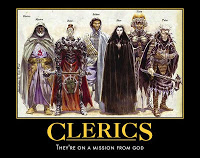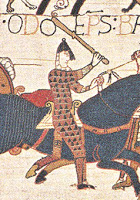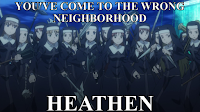 There is something of a dichotomy in the way the Dungeons & Dragons (and its descendants and emulators) approach religion. On the one hand, there are clerics, which as a class tend to transcend religious boundaries and be used for priests of wildly differing religions. On the other hand, there are druids, a sub-class of the cleric, who seem to follow a faith so different from those of the clerics that they are deserving of their own sub-class and spell lists, including dozens of unique spells.
There is something of a dichotomy in the way the Dungeons & Dragons (and its descendants and emulators) approach religion. On the one hand, there are clerics, which as a class tend to transcend religious boundaries and be used for priests of wildly differing religions. On the other hand, there are druids, a sub-class of the cleric, who seem to follow a faith so different from those of the clerics that they are deserving of their own sub-class and spell lists, including dozens of unique spells.
The question becomes; which is right? If clerics as a class are generic enough that the same class, and spell lists (albeit with reversed versions of spells being available), can be used for clerics of Saint Cuthbert (the lawful good god of wisdom, truth, zeal, and disciple) as well as clerics of Iuz (the chaotic evil demigod of deceit, oppression, and evil), then how is it that druids, whose veneration of nature seems at least as diametrically opposed to both of those as they do to each other, get a class unto themselves?
 The obvious answer is that clerics get their spells from deities, while druids get their spells from Nature, but this is belied by the fact that, in Greyhawk at least, some deities (such as Ehlonna and Obad-Hai) are said to be served by both clerics and druids alike!
The obvious answer is that clerics get their spells from deities, while druids get their spells from Nature, but this is belied by the fact that, in Greyhawk at least, some deities (such as Ehlonna and Obad-Hai) are said to be served by both clerics and druids alike!
Second edition did try to mitigate the problem of the over-extended cleric class by the addition of kits and spell spheres, which narrowed the range of spells available based on the particular deity. Third Edition did the same with prestige classes aimed at followers of specific deities. But in doing so, it also codified the notion that every character (or, at least, every cleric) had to be dedicated to a single deity, which is not always true in the sort of polytheistic society that most D&D campaigns use, and the rules heavily imply.
 |
| Bishop Odo from the Bayeux Tapestry. Note the club. |
That implication, by the way, is quite ironic, considering the heavily Christian origins of the cleric class as a whole. The idea of the cleric’s power over undead was lifted straight from Hammer Films Dracula movies (where doctor Van Helsing would flash a cross and “turn” Dracula), the rule against edged weapons comes from the historical figure Bishop Odo, who fought alongside William the Conqueror in 1066, and many of the spells come straight out of the Bible: bless, the various cure wounds spells, create food and water, cure blindness, cure disease, prayer, speak with dead, exorcise, sticks to snakes, tongues, flame strike, insect plague, raise dead, part water, earthquake, and resurrection.
So I propose that each religion get its own sub-class, handled along the same lines as the druid. There would still be clerics, but they would be priests of a particular religion (not necessarily monotheistic; Asatru or the Religio Romana are examples of polytheistic religions that have priests who serve all or most of the gods of that religion), to whom paladins would explicitly belong, as well as mystics (at least for those using the Adventures Dark and Deep™ rules, where mystics are explicitly stated to be part of the clerical religion, but coming at it from a different point of view).
 This opens up all sorts of possibilities, although it does entail a great deal of potential work for the game master. Imagine priests of different religions possessing vastly different powers and spell lists, where not every cleric is the “designated healer” by default (indeed, imagine a campaign where none of the priests are particularly focused on healing!), where priests of evil deities and demons aren’t just clerics with a different spell list and maybe an edged weapon if they’re lucky, but are as different from clerics as druids are.
This opens up all sorts of possibilities, although it does entail a great deal of potential work for the game master. Imagine priests of different religions possessing vastly different powers and spell lists, where not every cleric is the “designated healer” by default (indeed, imagine a campaign where none of the priests are particularly focused on healing!), where priests of evil deities and demons aren’t just clerics with a different spell list and maybe an edged weapon if they’re lucky, but are as different from clerics as druids are.
You might just get a taste of what that looks like come Halloween. Remember those two Darker Path books I wrote a couple of years ago? We’re about due for another one or two. Mua-ha-ha…









The specialty priests in the 2e Forgotten Realms hardcover book did this to an extent, though if I remember correctly the spell lists were not totally different, just limited by spell spheres.
Given bards, druids, and clerics are all of 'spiritual' origin (emerging in neolithic to pre Christian times) the 'patriarch' worshiping dwei-pater (an early Jupiter), and nature worshiping druids around/before this time, the Druid is the mainstream path and cleric the sub-class.
Towards the end of second edition, there were a few additional priest classes developed (Crusader, Monk, Mystic, Shaman, all found in Faiths & Avatars, all but the mystic in Spells & Magic) which form a fairly nice mid-way point between the extravagance of the specialty priests and the very limited generic cleric. I've asked around a few times online and everyone who has used these classes says they seem quite reasonable in play, and this jives with my own limited experience using them.
Instead of writing up explicit rules for subclasses based on specific gods, a kit type book similar to the complete priests' handbook which gives rules to DM's to create their own subclasses might be very good. And definately something I'd pay money for.
I've been treating priests as differing by deity for years now. I really like that the clergy of each deity in my campaign world are unique. Some have access to more weapons. Some are better or worse with undead. Many have unique spell lists, including unique spells or ones borrowed from magic-users. I think this is an area where a DM that really likes world building can go to town.
For players not really interested in this sort of thing, I also give them the option to be a generic "cleric" with book-standard abilities. However, they usually pick a deity and go with the specialization as it is a lot more interesting. This also opens up additional roleplaying opportunities, I've found.
I'm looking forward to seeing what you do along these lines, Joe!
Back in the day a local DM would make you choice a pantheon to worship, then a god or goddess as you main god. Or he let you worship only one or two gods from the same pantheon. If you worshipped the pantheon as a whole you were a “Cleric of the Most Powerful and Venerated _____________”. If you worshiped a single god or two you were a “Priest of ___________”. He gave the clerics better spells and power to turn undead, but the priests had better weapon selection and some bonus for spell damage etc.
His idea was you said a nightly prayer, hit the sack, woke up and did a morning prayer. If you needed to cast a spell you called on your main god or the god in that pantheon that was responsible for that sort of thing or the whole pantheon (mostly higher level stuff). So if you wanted to hit something with a lightning bolt you called out to Zeus if you worshiped the Greek pantheon, Thor if you worshiped the Norse pantheon or whoever, if no god was responsible you prayed to the whole pantheon.
Turning undead required both the holy symbol of you main god and the one responsible for the dead or the main god of the pantheon. You were required to carry the holy symbols of most of the pantheon, only the symbols of your god, the main god of the pantheon, and the god of the dead needed to be high quality, the rest could be smaller and lower quality.
I think the development of the druid is a result of the times. My impression from reading the OD&D era material (pre-Basic and pre-Advanced) is that good clerics got to turn undead, evil clerics got to control undead, and neutral clerics got to be druids. So, in that sense, there's no conflict as each works like it's own subclass.
I like that idea now as someone who's not actively playing right now, but it's not how I ever played and I played the Basic-Advanced (1st Edition) era.
I did the same as Keith Sloan above. I have clerics of the Norse, Greek and Egyptian pantheon, clerics of Set, Hecate, Dyonisus (Dyonisian Mysteries), Demeter (Eleusian mysteries) and some other minor deities. Each one accesses to spell lists differently, can use different weapons (or none at all in the case of Eleusian priests) and has different taboos or obligations. So far I've had 4 clerics in my game and each one has been very unique, opening many roleplaying opporunities (that have been seized greatly btw).
I did the same as Keith Sloan above. I have clerics of the Norse, Greek and Egyptian pantheon, clerics of Set, Hecate, Dyonisus (Dyonisian Mysteries), Demeter (Eleusian mysteries) and some other minor deities. Each one accesses to spell lists differently, can use different weapons (or none at all in the case of Eleusian priests) and has different taboos or obligations. So far I've had 4 clerics in my game and each one has been very unique, opening many roleplaying opporunities (that have been seized greatly btw).
I feel subclasses like Druid & Monk should be traditional (aforementioned) or be custom – described by the Player & designed by the DM. I believe deities or pantheons or whatever should have limited spell lists, but again I let the players choose (mostly, Alignment counts).
In props to kits, they are a lot easier to implement than full subclasses and allow customization the the small during pre-game as well as maintaining Turning, the primary feature of clerics.